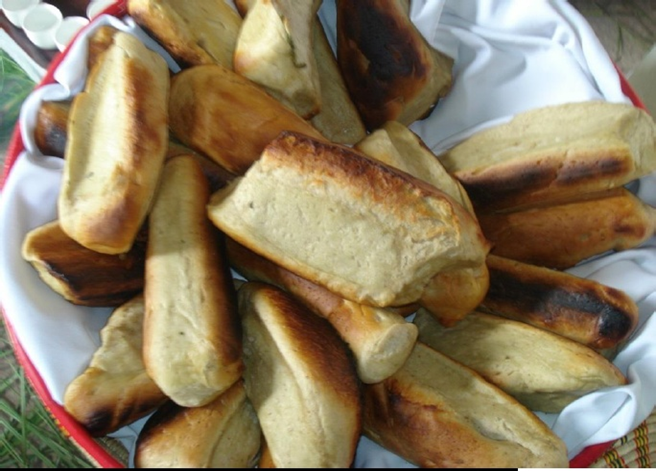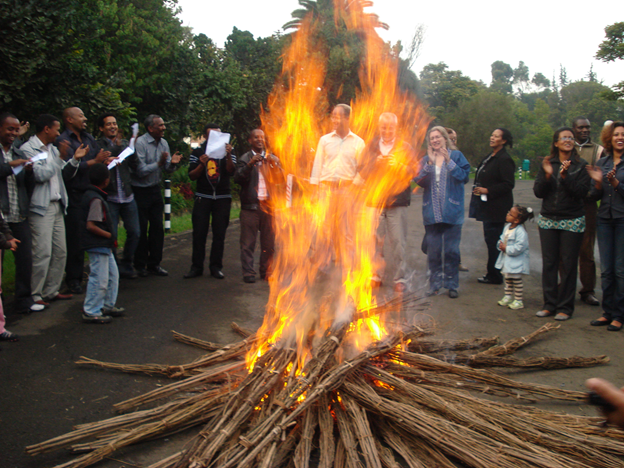Ethiopia is truly a place of great culture and celebrations. One worth witnessing is Buhe which is celebrated on August 19 of every year. Religiously the day marks the transfiguration of Jesus on mount Tabor. The celebration performed by young boys and men all over Ethiopia is breathtaking and exciting to watch in Addis Ababa and at the regional states. It represents the approach of bright weather and the end of the rainy season.
The day known as hoya hoye is stunning particular special event of young boys and men. They go from one house to another in their neighborhood making specialized poems to praise the household owners and express their good wish for the upcoming Ethiopian New Year. It’s tradition to hold a stick as an instrument. The children make the sound by hitting the ground with it while they sing following the lead singer in a rhythmic way. The lead singer is selected from the group for his good voice. After the group finishes praising the household owners they will be awarded and given appreciations by homemade breads (mulmuls) or money as they leave blessing the families in the household.
The special day is also symbolized with a whip (geraf) which is usually made of tree barks and braided fibers. The sound of cracking whips echoes in most neighborhoods signal the approach of the holiday and the end of the rainy season. In regional states areas male shepherds form small groups and go to hill tops to enjoy cracking the geraf they made, usually comparing the sound of one whip with the other intended to notify the neighborhood about the celebration.
It is part of the Buhe custom that mulmuls are prepared in every household of both rural and urban communities Jumia Travel learnt. As a sign of unity and affection neighbors exchanging their specially made mulmuls between close relatives and family members. At night of the celebration people gather outside of their home to light a bundle of dried twigs tied together (chebbo). The song Hoya Hoye continues but this time in great cheer, clapping and running around the burning chebbo which also makes this particular day a celebration of the rainy season before it departs and welcoming the New Year with new hope. Lighting chebbo torches takes place outside of the dwelling or in front the premises of each house with a large gathering of family members. Families go around the flickering fire singing and dancing enjoying a moment of celebration and togetherness until the fire burned down fully.
The celebration ends with a great gratitude and wishes to welcome Enkutatash (gift of jewels) which marks the Ethiopian New Year based on the Coptic calendar of Julian calculation. There is eight-year gap between Ethiopian calendar and that of the world which follows the Gregorian calendar. Enkutatash signifies the end of the rainy season and arrival of the sunny weather. The tradition goes back 3,000 years to commemorate the Queen of Sheba of ancient Ethiopia and Yemen who visited King Solomon of Israel in Jerusalem. She had gifted Solomon with 120 talents of 4.5 tons of gold as well as unique spices and jewels. When the Queen returned to Ethiopia her chiefs welcomed her with enku (jewels). This remained to be the symbol of the Ethiopian New Year. The Ethiopian New Year continues to be celebrated for 17 consecutive days with people greeting east other with enkuanaderseachew (welcome to the New Year). Celebration will be concluded with Meskel which is another bigger event of the Ethiopian tradition.
Following Enkutatash Meskel (Cross), the magnificent carnival is celebrated for two days beginning September 27th. It is one of the most colorful festivals celebrated by local Christians for more than 1600 years. It marks the bright warm weather at the end of the rainy season. It involves dancing, feasting and lighting a massive bonfire to commemorate the discovery of the “true cross” on which Jesus Christ has been crucified.
By Eden Sahle


